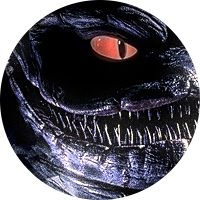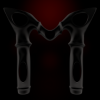Search the Community
Showing results for tags 'normal'.
-
Hello, I am facing an issue when trying to import an object that I created in MoI3d into 3D-Coat. Whenever I try to import the object in question for surface sculpting or vertex painting I get these facets: However, when I try to import the objects for per pixel painting I get a dialog box which gives me the option of checking "Lock Normals". After I do so, the facets which were in my mesh before dissappear: Sometimes I quickly want to paint and render a model inside of 3D-Coat without going through the trouble of retopologizing the model and then uv unwrapping it, so is there an option to also "Lock Normals" when importing a mesh for vertex painting? Thank you.
-
Here is a short video of baking a sculpt into a low poly model and then some parts of model dissapear. What is going on? What am I doing wrong? 2022-06-13 23-51-59.mp4
-
Hello. I'm looking for help. So here is my low-poly mesh, and it looks fine in 3d-coat. (pic 1) But if we take a look at it's normal maps (pic 2), we see it's being split at UV-Island edges. If I understand correctly those edges should not be there and they seem to cause wrong look in 3ds max or another software. The question is: am I missing something? Why does 3d coat break normal map on those edges? How do I bake it right? Tried switching GL and DX versions - to no avail. Tried different baking presets (for 3ds max, for Unity etc) - all the same. (There is another thread on this forum where a guy had similar issue, but that solution did not work for me (He had to update 3d coat and switch GL to DX)) Thanks in advance!
-
I baked some mesh maps in Substance Painter for an old project. It's an atlas of small items for detailing an environment (bottles, books, cans) In Substance, the OpenGL maps bake perfectly. Here are screenshots from Substance Painter: I decided that there were a lot of cereal boxes, logos and things I would need to paint in an external image editor, and I liked Coat's linking option (for Affinity). So I ported the project over to Coat. I imported the normal map with the correct settings. The normal map doesn't show up correctly. I double-checked and toggled the green channel to be sure. The dark halos around the triangles are horrible in 3D Coat. Here's a screenshot: So I tried re-importing the normal map and even creating a new project and changing the UV smoothing settings. To no avail. Then I discovered the problem. The software preset Blender and Unity yield different results, even though they should both be exactly the same (an OpenGL normal map with an inverted green channel). SO, I created my own normal map preset and called it OpenGL. I didn't do anything at all, I just made a new one. Now everything shows up great! This is a screenshot from 3D Coat: There should not be a Unity normal map preset vs a Blender normal map preset. They should not be different. There should only be an OpenGL and a DirectX setting for normal maps. Also, imported OpenGl maps using those presets show up wrong, and it will anger a lot of new users coming from other software. I'm also happy to share the model and normal map for anyone to verify my findings here. I'm using 4.8.32-SL(GL64) Atlas_1_Bake.obj
-
I try to change normal sampling value to minimal = 5 - but it not change behavior of the brush. It begin change it angle to surface similar to normal sampling = 100 as soon as the edge of brush cursor touch the vertical surface - the brush begin change its tilt. But when normal sampling is = 5 - tilt of the brush must change when center of brush cursor will approach to vertical surface - but not edge of cursor. Only in Flatten tool - normal sampling work good I already reset Options-files in Documents/3D-Coat - it dont help( How to fix this problem?
-
у меня есть модель специально разделённая на разные ретопо группы. Это сделано для того чтобы можно было скрывать часть лоу-поли модели и часть floating geometry на хай-поли - в местах где она пересекается с другой плавающей геометрией для других частей модели. Проблема в следующем: когда я запекаю нормал для одной части модели, потом скрываю её и включаю следующую часть модели и запекаю новые детали - то ещё один нормал мап уже не рендерится. Просчёт идёт - но нормал мап так и не появляется. Если же удалит старый нормал мап - то новый просчитывается без проблем, но следующий не просчитывается опять. Как отрендерить несколько нормал мап с разных участков геометрии?
-
What are the proper export settings for normal maps from 3D Coat to Maya (Arnold IOR)? In File > Preferences I have tried using numerous normal settings (Software Preset, Calculation Method, Swap TB), but I still feel like my normals are looking inverted in the Maya Arnold render. What is the proper normal map export workflow?
-
Hi all trying to export normal maps to be used in unity, but they get inverted. So i found out that you have to invert the green channel. But isent there a way to do that in the exporter so i dont have to go into PS to invert it?
-
Hi guys! I have 12mb 2k Normal map, when i apply it directly to a mesh (via import texture file) it reads fine, the quality is 100%. When i plug this same texture into a Smart Material (using the same exact scale) and apply it to the same mesh the result is very undesirable. I can only assume the Smart Material compresses the life out of the Normal Map for the sake of speed and hence the quality being very poor. Is there a way to potentially solve this? Below are examples : Direct Normal - Smart Material Normal - Lastly i'll add a .Rar file with the texture used and the mesh (simple UV unwrap). Hopefully this will provide Hands-on understanding. Cheers, Alex. Normal Map Comparison.rar
-
The problem i have is the following : -I unwrapped my UVs fine -I then baked my normals (with the default shader & name correspondance for baking unchecked as it seemed to cause problem) -Normals are fine in the paint room I tried exporting the object from the retopo room (Export Retopo Object) & from the paint room (Export Object & Textures), and in those 2 cases, i get a weird UVW mapping in C4D : Also, in the Retopo room, i can't move retopo meshes in other UV Sets. I tried with my mesh selected or not in the Retopo room, with the initial object layer selected in the Voxtree or not... Anybody has ideas ?
-
i am trying import normal map to my model but normal map did not display correctly but my normal map show correctly in maya and Marmoset Toolbag 3 iam using 3dcoat 4.7.12 trying to invert green channel but no change
-
We are having problems exporting geometry/textures from 3D Coat to 3ds Max. We are particularly interested in the normal map export, and subsequent application to the model in Max. For testing we have created a simple cylinder, and applied a brick texture. The normal map we have was originally created from a height-map inside of 3d Coat. If anyone wishes to download the 3b file, I've popped it here. We select Export from 3d Coat, and so far have tried both OBJ and FBX and get the same result. We then import the geometry into Max, and set a "Normal Bump" map type onto the Bump channel of a Standard Material, and apply the exported normal texture to the "Normal" slot in that map. We keep Channel Direction as default (all unselected), and Method as "Tangent". If we choose to scanline render, we find that the cylinder has an incorrect seam (See attached image). In more complicated scenes, there are more visible seams, seeming to coincide with UV atlas edges. Atlas We have chosen the "3D-Max" option for "Normal Map Software Preset". Our full options are: We have also tried flipping, but no setting got rid of the seam: Swap Y & Z Scene Axes Normals Calculation Method (3D-Coat / Maya Normals) Tangent Space Standard (mikkTSpace / Lengyell / Unity) I am figuring that this has to be an expected workflow of 3D Coat, but somehow we have a setting wrong somewhere. I'm unsure of whether this is a 3D Coat setting, or in our setup inside of 3ds Max. The Max file (2017) is here, and the texture here. Can anyone see what is wrong? Thanks in advance Andy Yelland Technical Director
-
I'm having problems exporting normal maps from 3DC for use in Element3D. This is purely the normal map. All other maps do not show the UV seams - I deliberately UV'd with these seams so I could check the problem. I don't know what normal standard Element3D uses, but so far, I cannot get round the normal generating these seams. If I export a displacement map from 3DC and have Element3D 'convert grayscale', that works, but actual normal maps don't work, so far. Does anyone have this workflow up and running? I've tried the presets one after the other, but cannot get round this. Thanks.
-
Hi A little feature whish I have is to have clip masks for normal maps layers. It would work like that: A clipped normal map would just blend to the value RGB = 0.5 0.5 1 It would make normal and depth blending with the follwing layers easier. Thanks for considering -ray
-
Does anyone know about an efficient way of placing copies (or ideally - instances) of an object on a surface of another object, with respect to normals of that surface? I know I can do this outside of 3D-Coat, but I'd like do it without leaving Sculpt Room.
-
Hey there Coaters, I am having an odd problem importing a hi poly .fbx into the sculpt room. I import it and as usual hit enter to set the mesh without modifications, then when I switch to the 'build clay' brush, my models normals come up reversed. This is one component of a larger model. All components are built with the same technique within Maya. I had a workmate look over it and try to save it out of Max, yet to no avail, still reversed normals. The only solution I found was to do 'Combine' within Maya. By adding another piece of geo to it, the problem goes away and both meshes have correct normals when imported to the sculpt room. Any ideas why this would be happening? Pics below... Thanks Guats
-
When working on models for video games which require low resolution textures and normal maps (512x512 maximum), I sometimes run into the problem that normal maps come out pixelated while other times they do not. It's weird because sometimes they are smooth, others they are pixelated... and others they are both... Do you guys know some tips for avoiding pixelation (or what causes it) when baking normal maps at low resolutions? I've tried to find help on this but the recurring solution is increase the resolution... not really an option for me. Here is a recent example of some being pixelated and some being smooth: I tried many different ways of marking the seams, scaling the islands, separating different parts but nothing works. This is an example of a model that refuses to not be pixelated. Original model: Mesh: Mesh with Normal Map and Simple Textures (512x512): And normal map (the island on the top left is the inside which will not be seen so it is not properly mapped, I tried shrinking that and increasing everything else as well but that didn't work either):
-
Does anyone know if there is a way to adjust how More in cavity and less in cavity work when painting a normal mapped model, If not this would certainly be an improvement for 3d coat, its very handy for making things look worn and eroded but depending on your model you may want to adjust the allowance between what is classed as a cavity thanks.
- 3 replies
-
- More in cavity
- less in cavity
-
(and 8 more)
Tagged with:
-
I don't know if this is considered critical, but some might. Please see thread below: http://3d-coat.com/forum/index.php?showtopic=10976 My setup is in my signature below, and I'm using the Win 7 64-bit CUDA version 3.7.18F (or H, I don't know, as it never shows the H in the header). If you need more system info, etc., let me know.
-
Hello all. I have a bucket that I made some time back with 3ds Max and brought into Mudbox. I painted it and render it out and put it into the UDK. It was OK for the time I had to do it, but now I want to try my hand at voxelizing it in 3DC and going through the motions. I have sculpted in details in the Voxel Room, but any time I Autoretopo this, it's aweful. Am I stuck with doing this one by hand? Voxelized Bucket: Autoretopo Problem:










